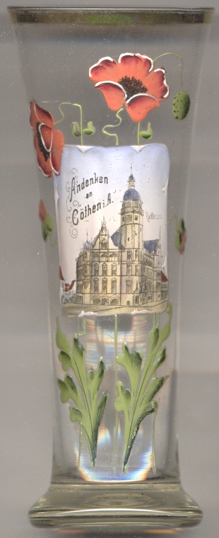

|
| DEUTSCHLAND | GERMANY |
| Bundesland: Sachsen-Anhalt | Saxony-Anhalt |
| Landkreis: Anhalt-Bitterfeld |
 Köthen (Anhalt) (officially spelled Cöthen between 1885 and 1927) is situated at an elevation of 80 m in the fertile area of the
Magdeburger Börde, about 48 km southeast of Magdeburg and 28 km north of Halle (Saale).
It is the seat of the district Anhalt-Bitterfeld. The municipality has a population of about 24,900 (2021).
Köthen (Anhalt) (officially spelled Cöthen between 1885 and 1927) is situated at an elevation of 80 m in the fertile area of the
Magdeburger Börde, about 48 km southeast of Magdeburg and 28 km north of Halle (Saale).
It is the seat of the district Anhalt-Bitterfeld. The municipality has a population of about 24,900 (2021).
Owing to the fertile soil of the region, the area of Köthen is unusually rich in archaeological discoveries. The earliest signs of human habitation date from the early Stone Age about 250,000 years ago. The first documentary mention of Cothene dates to 1115; by 1194 it was already known as a market town, becoming a seat of the princes of Anhalt. Köthen was chartered in 1200. For over two centuries (1603–1847) it was the capital of the independent principality (from 1806, duchy) of Anhalt-Köthen. The town has long been known to classical music enthusiasts as the place of origin of Johann Sebastian Bach's best-known secular works, including the Brandenburg concertos and the Well-Tempered Clavier. Bach worked in Köthen from 1717 to 1723 as Kapellmeister at the princely court. It is also the birthplace of the composer Carl Friedrich Abel who, together with Johann Christian Bach, founded the popular "Bach-Abel Concerts" in London, the first subscription concerts in England. Samuel Hahnemann, the founder of homoeopathy, practised in Kööthen from 1821 to 1834, and during this period he published many of his best-known works. When the last duke of Anhalt-Köthen died without male heir in 1847, the country was inherited by Anhalt-Bernburg. In 1998 the town was officially renamed from Köthen (Anh.) to Köthen (Anhalt). In 2007, the former district Köthen was merged with the district Bitterfeld and parts of the former district Anhalt-Zerbst. The new district took the name Anhalt-Bitterfeld, the seat of the district administration was placed in Köthen (Anhalt).
 Schloss Köthen [left, no. 4194] began as a castle built from 1156 to 1160 on an earlier island
castle controlled by the Ascania Counts of Ballenstedt. The castle burned in 1547, leaving only its northern portion. it was
renovated into a Baroque palace over the late 16th and then 17th centuries. More renovations, in the interiors, were made in the Neoclassical style from
1821 to 1833. The palace was the residence of the Princes and Dukes of Anhalt from 1244 to 1847. After 1603, it was the seat of the Anhalt-Köthen
line until it became extinct in 1847. In the 17th century, the palace was the seat of the Fruitbearing Society, an early society for the promotion of the
German language.
Schloss Köthen [left, no. 4194] began as a castle built from 1156 to 1160 on an earlier island
castle controlled by the Ascania Counts of Ballenstedt. The castle burned in 1547, leaving only its northern portion. it was
renovated into a Baroque palace over the late 16th and then 17th centuries. More renovations, in the interiors, were made in the Neoclassical style from
1821 to 1833. The palace was the residence of the Princes and Dukes of Anhalt from 1244 to 1847. After 1603, it was the seat of the Anhalt-Köthen
line until it became extinct in 1847. In the 17th century, the palace was the seat of the Fruitbearing Society, an early society for the promotion of the
German language.
[https://de.wikipedia.org/wiki/K%C3%B6then_(Anhalt), https://en.wikipedia.org/wiki/K%C3%B6then_(Anhalt)]
![[scale]](lineal.jpg)